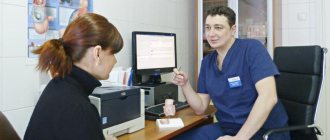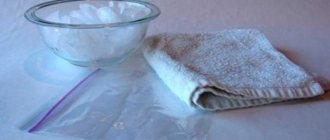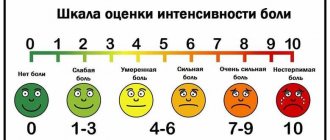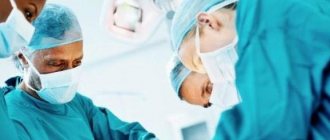Hemorrhoids in pregnant women develop according to the same pattern as in other patients; the clinical manifestations of hemorrhoids depend on the stage of the disease. External hemorrhoids are rare and there is usually no bleeding from them. The chronic course of internal hemorrhoids is divided into 4 stages. At the 1st stage - discharge of blood from the anus without prolapse of hemorrhoids, at the 2nd - prolapse of nodes with independent reposition into the anal canal (with or without bleeding), at the 3rd - periodic prolapse of nodes with the need for their manual reposition into the anal canal anal canal (with or without bleeding), on the 4th – constant prolapse of hemorrhoids along with the rectal mucosa and the impossibility of reduction into the anal canal (with or without bleeding). The main clinical manifestations of hemorrhoids include: bleeding (including traces of blood on toilet paper), discomfort, itching, mucous discharge.
What are hemorrhoids - types, symptoms, features in pregnant women
Hemorrhoids are a disease in which the vessels in the anus dilate and form hemorrhoids - inside the anus or outside under the skin.
Internal hemorrhoids form inside the anal canal. Internal hemorrhoids are often painless, but they can prolapse and bleed. External hemorrhoids form near the anus. If a blood clot develops in one of the external hemorrhoids, severe pain may occur. External hemorrhoids feel like a painful, hard hemorrhoidal lump. Hemorrhoids develop under the influence of certain factors. Pregnancy, along with other risk factors, contributes to the development of hemorrhoids. The incidence of the disease in pregnant women increases in the second and third trimesters of pregnancy, as well as immediately after childbirth.
A growing uterus with a fetus and a sedentary lifestyle lead to impaired blood flow from the pelvis; chronic constipation in pregnant women contributes to excessive straining during bowel movements, which in turn contributes to the prolapse of nodes from the anus.
Symptoms of hemorrhoids can vary: bleeding after bowel movements, pain, prolapse of nodes, sensation of a foreign body in the rectum. In addition, hemorrhoids can be characterized by a chronic course (chronic hemorrhoids): with minor, mildly expressed symptoms; and acute, in which there is a sharp pain in the anus and a rapidly swelling painful node or several nodes appear, which thrombose under the influence of certain factors. Thrombosis of the hemorrhoid is an indication for surgical treatment (if the disease is no more than 3 days old). This is also an indication for the treatment of exacerbation of chronic hemorrhoids. Other symptoms of acute hemorrhoids can be treated by adjusting the treatment regimen and prescribing medications.
Diet for constipation and hemorrhoids
A very important condition during treatment is to review your diet. A diet for hemorrhoids and constipation will help you quickly get rid of the problem, avoid rupture of the hemorrhoids and aggravation of the inflammatory process.
| Authorized Products | Prohibited |
|
|
Meals for hemorrhoids and constipation should be small and frequent (6 - 7 times) in small portions, and you should also consume a sufficient amount of water (from one and a half liters per day).
Now let's take a look at the sample menu for constipation and hemorrhoids .
Breakfast:
- omelette, boiled broccoli;
- steamed fish, 1 tomato;
- wheat porridge cooked with milk, dried apricots;
- soft-boiled egg, mild cheese;
- low-fat cottage cheese with grated apple or prunes.
II breakfast:
- cottage cheese casserole, sour cream;
- fermented baked milk with a small amount of bran;
- fresh berries;
- carrot salad;
- apple-curd casserole.
Dinner:
- millet soup, steamed fish with vegetables;
- lean borscht, stewed veal, vegetable salad;
- chicken broth with cereal, mashed potatoes with boiled chicken.
Afternoon snack:
- fruit jelly;
- bran yogurt;
- grated carrots with sour cream and honey;
- fruit salad with yogurt.
Dinner:
- omelet, fresh cucumber salad;
- steamed fish, stewed vegetables;
- steamed meat cutlet, cucumber salad.
How to cure hemorrhoids in pregnant women
The main difficulty in treating hemorrhoids in women during pregnancy and after childbirth is choosing drugs that can most effectively cope with the symptoms and are safe for the woman and child.
The pharmaceutical market offers a wide range of effective drugs with different trade names, many of them are made from natural substances and are safe for pregnant and lactating women. However, before prescribing any drug, consultation with a doctor is necessary to discuss the advisability of its use, the risk-benefit ratio and obtain recommendations.
Conservative (medicinal, non-surgical) methods often do not cure hemorrhoids, but only temporarily relieve unpleasant symptoms.
However, in some cases (ineffectiveness of conservative therapy, stage III-IV hemorrhoids, thrombosis of the hemorrhoid, complicated course, subjective complaints and patient desire), surgical treatment is necessary. Currently, there are minimally invasive techniques, low-traumatic methods that can relieve the disease for a long period of time without the need for the use of strong analgesics.
Until recently, pregnancy was a relative contraindication to surgical removal of hemorrhoids. This is primarily due to the need to use anesthesia during surgery, as well as prescribe painkillers. As is known, many medications are not recommended for use during pregnancy and lactation due to a possible toxic effect on the developing body of the child.
Our clinic provides both conservative and surgical treatment of hemorrhoids in pregnant women. If the task is to cure external hemorrhoids, the matter is often limited to drug therapy. For internal hemorrhoids, surgical methods are used.
How to treat?
How to get rid of constipation with hemorrhoids ? This question worries almost all patients. Medicines will help solve the problem, but they should be prescribed by a proctologist after an examination. However, how to go to the toilet if constipation has developed due to hemorrhoids , and there is no way to get to the doctor right away?
- Oil microenema. You can take sunflower, olive, flaxseed, castor oil and heat it in a water bath to 37 - 38 degrees, then give an enema. It is better to perform the procedure before going to bed, since the oil enema does not work immediately. Heated oil envelops hardened stool and promotes its movement without damaging the mucous membrane. An oil enema for constipation and hemorrhoids is the “mildest” procedure; it does not expose the body to stress.
- If the situation requires immediate action, an enema with 10% saline solution will help. It creates some discomfort, but acts quickly.
- Rectal suppositories for constipation and hemorrhoids , which contain glycerin. They act gently and have a harmless composition.
- At the same time, you can help yourself by using some food products. A mixture of prunes, figs and dried apricots, minced in an equal amount in a meat grinder, helps a lot. Mix all ingredients and take 1 tsp. every day 30 minutes before meals. You also need to follow a drinking regime, drinking up to 1.5 - 2 liters of still water.
- Laxatives for constipation and hemorrhoids are prescribed only by a doctor!
Surgeries to remove hemorrhoids in pregnant women in our clinic
The department has the technical equipment to perform all types of surgical intervention for hemorrhoidal disease, ranging from latex ligation to ultrasonic removal of hemorrhoids.
- Ligation of hemorrhoids. This method is used to treat internal hemorrhoids, when the manifestations of hemorrhoids include prolapse of self-reducing hemorrhoids and moderate bleeding during bowel movements. The essence of the method is that a small latex ring is placed on the hemorrhoidal node, which compresses its base with the vessels passing through it, stopping the blood flow in the node. After several days, the knot and the ring fall off, and the resulting wound heals within 1-2 weeks. This procedure is most often virtually painless.
- Sclerotherapy and infrared photocoagulation. These methods are suitable for the treatment of hemorrhoidal disease, manifested only by bleeding without prolapse of nodes.
- Hemorrhoidectomy is a surgical operation aimed at removing hemorrhoids. This is the best way to achieve complete disappearance of all symptoms. Surgical removal of internal hemorrhoids is used for prolapsed and non-reducible nodes, or when the effect of outpatient treatment is not observed, or when outpatient treatment is impossible. During surgery, excess tissue that is a source of bleeding is removed. To make the patient more comfortable, the operation is performed under spinal anesthesia with sedation.
Photo of hemorrhoids in a pregnant woman BEFORE
Photo of hemorrhoids in a pregnant woman AFTER
Taking into account the conducted research, standards for the management of patients with hemorrhoids during pregnancy and lactation have been developed, allowing for the safest possible surgical intervention and ensuring adequate postoperative pain relief. The Clinic of Coloproctology and Minimally Invasive Surgery is located in the same institution as the Clinic of Obstetrics and Gynecology. This allows us to monitor patients after surgical treatment together with gynecologists.
You should always remember that pregnancy is a special condition that requires careful monitoring and an individual approach. Therefore, even drug treatment and regime correction require consultation with a qualified specialist.
Preventing constipation with hemorrhoids
Everyone knows that preventing a disease is easier than treating it. Let's do prevention.
- Review of diet. It is necessary to eat foods rich in dietary fiber: fresh vegetables, fruits, bran, nuts, dairy products. Limit meat, fat, alcohol, viscous cereals. If there are no contraindications, you should drink 1.5–2 liters of water or compote without sugar.
- Diet. It is recommended to eat 3-4 times a day, with a break of no more than 4-5 hours between meals. It is not advisable to eat food 2 hours before bedtime.
- Defecation mode. Bowel movements should be done daily. It is forbidden to suppress the urge to defecate, as well as uncontrolled use of constipation pills.
- Physical activity. This prevents fecal stagnation, as it enhances peristalsis and improves blood supply to the intestines.
- Stress control. In life, it is not always possible to avoid stressful situations, but trying to control your emotions during nervous tension is simply necessary.
Constipation due to hemorrhoids is a dangerous condition that can cause serious consequences. Do not self-medicate, but contact a proctologist!
The main causes of spasms in children
The diseases and causes that can lead to this problem are quite extensive. It is worth noting that in children, spasms and pain are most often observed in the gastrointestinal tract and accompany various organic and functional diseases of the stomach and intestines. The difference between organic and functional diseases lies in the presence of structural or biochemical changes in organs and tissues. Organic diseases have them, but functional ones do not. Functional pathology is caused by changes in the regulation of these organs, which can also cause symptoms similar to organic ones. In young children, spasms are more often observed against the background of functional pathology. With age, the incidence of organic pathology increases. The most common causes of excessive contraction and abdominal pain in children are:
- Intestinal colic.
- Functional diarrhea and constipation.
- Acetonemic syndrome.
- Biliary dyskinesia, inflammation of the gallbladder.
- Gastritis, peptic ulcer.
- Diseases accompanied by malabsorption syndrome. Malabsorption is a malabsorption of substances in the small intestine.
- Inflammatory bowel diseases.
- Chronic colitis, intestinal infections, parasitic infestations.
There are also many other diseases that are accompanied by excessive contraction of muscle cells and pain. We list only the most common of them. Often spasms are accompanied by inflammatory diseases of the urinary tract (cystitis, pyelonephritis). In this case, they occur in the urinary tract. Often, during the formation of the menstrual cycle, teenage girls may experience severe cramps and pain in the lower abdomen. This problem is called dysmenorrhea. Vascular spasms often develop when the temperature rises in children, which is characterized by the appearance of “white fever”. In this article we will briefly talk about the main causes of spasms in children, as well as the diseases that lead to them. Let us explain the basic principles of use and the mechanism of action of drugs used for this pathology.
There are many other diseases that are accompanied by excessive contraction of muscle cells and pain.
Table of antihemorrhoidal ointments allowed during pregnancy
For the convenience of pregnant women, all the ointments presented above are summarized in a table that will help you understand in which trimester of pregnancy this or that medication is allowed.
| Means | Trimesters | ||
| I | II | III | |
| Ichthyol ointment | + | + | + |
| Heparin ointment | – | + | +/- |
| Gepatrombin G | – | + | + |
| Vishnevsky ointment | + | + | + |
| Levomekol | + | + | + |
| Fleming's ointment | + | + | + |
| Posterisan | + | + | + |
| Troxevasin | + | + | + |
| Troxerutin | – | + | + |
| Relief | In consultation with the doctor | ||
| Bezornil | According to strict indications | ||
| Procto-Glyvenol | – | + | + |
| Relief Advance | In consultation with the doctor | ||







